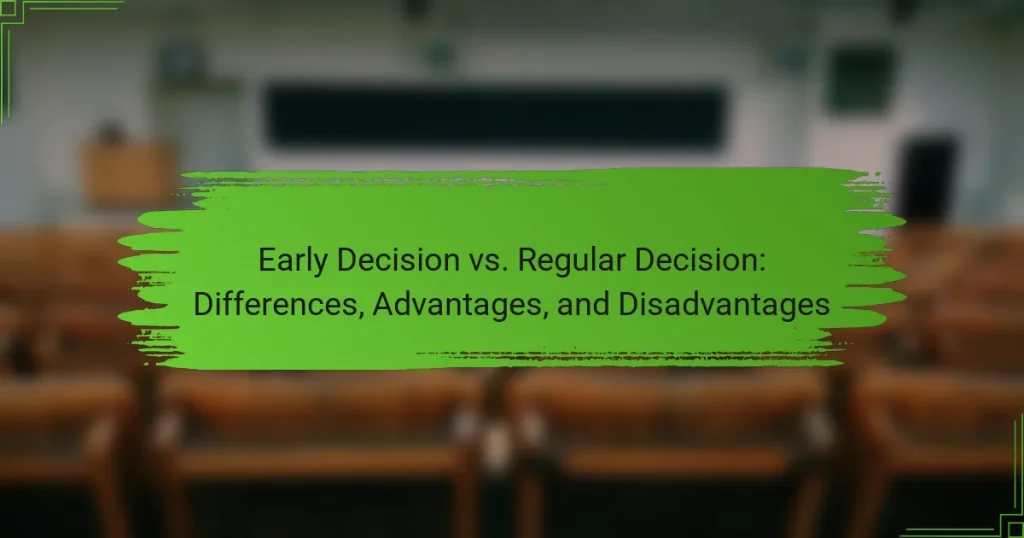
What are Early Decision and Regular Decision?
Early Decision is a binding college admissions option. Students commit to attending a specific school if accepted. Regular Decision is a non-binding option. Students can apply to multiple schools and choose later. Early Decision deadlines are typically in November. Regular Decision deadlines are usually in January or February. Early Decision applicants often receive notifications by December. Regular Decision applicants typically hear back in the spring. These processes help students plan their college choices effectively.
How do Early Decision and Regular Decision differ in application processes?
Early Decision and Regular Decision differ primarily in their application timelines and commitment levels. Early Decision applications are submitted typically by November 1 and require students to commit to attending if accepted. This binding agreement limits students’ options but can enhance chances of admission at competitive schools. Conversely, Regular Decision applications have deadlines usually around January 1 and do not require a commitment until students receive multiple offers. This allows students to compare financial aid packages and choose among several options. The differences in timelines and commitment levels significantly impact applicants’ strategies and decision-making processes.
What are the deadlines for Early Decision and Regular Decision applications?
Early Decision applications typically have a deadline around November 1st. Regular Decision applications generally have a deadline of January 1st. These deadlines can vary by institution. Many colleges publish their specific dates on their admissions websites. It’s important to check each college’s requirements. Adhering to these deadlines is crucial for timely application processing.
What are the requirements for each application type?
Early Decision applications typically require a binding commitment to enroll if accepted. Applicants must submit their application by a designated early deadline, usually in November. They often need to provide standardized test scores, transcripts, and letters of recommendation. Additionally, a signed agreement from a parent or guardian may be necessary to confirm the binding nature of the decision.
Regular Decision applications have a non-binding nature, allowing students to apply to multiple schools. The deadlines for these applications are generally later, often in January or February. Similar to Early Decision, applicants must submit transcripts, test scores, and letters of recommendation. However, they do not require a binding commitment to attend if accepted.
What are the key characteristics of Early Decision?
Early Decision is a college admissions process that allows students to apply early and receive an admission decision sooner. This option is binding, meaning students must attend if accepted. Typically, applications are due in November, with decisions released in December. Early Decision can demonstrate a student’s strong interest in a particular institution. It may improve chances of admission compared to Regular Decision. However, students must consider financial implications, as they cannot compare financial aid offers from multiple schools. Early Decision is not suitable for all students, especially those uncertain about their college choice.
What are the implications of committing to an Early Decision?
Committing to an Early Decision (ED) implies a binding commitment to attend a specific college if accepted. This means students must withdraw applications from other institutions upon acceptance. Early Decision often leads to higher acceptance rates; for example, some schools report rates 10-20% higher for ED applicants. Students may also receive financial aid packages earlier, allowing for better planning. However, ED applicants may face limited options for comparing financial aid offers. Additionally, the commitment can pressure students to choose a college without fully exploring alternatives. Overall, the implications of ED include a binding commitment, potential for increased acceptance, and challenges in financial aid comparison.
How does the acceptance rate compare to Regular Decision?
Early Decision acceptance rates are typically higher than Regular Decision rates. For example, a university may have an Early Decision acceptance rate of 50% compared to a Regular Decision rate of 25%. This trend occurs because Early Decision applicants demonstrate strong interest and commitment to the institution. Additionally, Early Decision pools are often smaller, allowing colleges to be more selective during Regular Decision. Therefore, applying Early Decision can increase an applicant’s chances of admission.
What are the key characteristics of Regular Decision?
Regular Decision is a college admissions process that allows students to apply by a specific deadline and receive their admission decision later. The application deadline typically falls in January or February. Students often have until May 1 to accept an offer of admission. Regular Decision does not require a commitment to attend if accepted. This option is available to all applicants, regardless of their academic performance. It allows students to compare multiple offers before making a final choice. Regular Decision is less binding than Early Decision, providing more flexibility for applicants. Many colleges use Regular Decision to fill remaining spots after Early Decision admissions.
What flexibility does Regular Decision offer to applicants?
Regular Decision offers applicants the flexibility to apply to multiple colleges simultaneously. This process allows students to consider various options without being bound to a single institution. Applicants can take additional time to improve their academic credentials or finalize their college preferences. Regular Decision deadlines typically fall later than Early Decision deadlines, often in January. This extended timeline enables students to receive and compare multiple admissions offers. Furthermore, applicants can weigh financial aid packages before making a final decision. This approach reduces pressure and allows for a more informed choice regarding college selection.
How does the timeline for Regular Decision applications work?
The timeline for Regular Decision applications typically follows a structured schedule. Most colleges set a deadline for Regular Decision applications around January 1 or January 15. Applicants usually receive admission decisions by late March or early April. This timeline allows students to apply to multiple schools without the pressure of early commitments. Furthermore, Regular Decision applicants have the opportunity to compare financial aid offers before making a final choice. According to the National Association for College Admission Counseling, this process provides flexibility and time for thoughtful decisions.

What are the advantages of Early Decision?
Early Decision offers several advantages for college applicants. Firstly, it can increase acceptance rates. Many colleges admit a higher percentage of Early Decision applicants compared to Regular Decision applicants. For instance, schools like Duke University report significantly higher acceptance rates for Early Decision candidates.
Secondly, Early Decision can reduce stress for students. Knowing their college choice early allows them to focus on their senior year without the anxiety of waiting for Regular Decision results.
Additionally, Early Decision demonstrates commitment. Colleges appreciate applicants who show a strong interest in their institution, which can enhance the applicant’s profile.
Lastly, Early Decision can lead to financial benefits. Some colleges may offer better financial aid packages to Early Decision students. This can help families plan their finances more effectively.
How can Early Decision benefit students?
Early Decision can benefit students by increasing their chances of admission to their preferred college. Students who apply Early Decision often demonstrate strong interest and commitment to the institution. This can lead to a higher acceptance rate compared to Regular Decision applicants. According to the National Association for College Admission Counseling, Early Decision applicants are accepted at rates up to 20% higher than those who apply Regular Decision. Additionally, students who are accepted Early Decision can focus on their senior year without the stress of college applications. This allows them to engage more fully in academics and extracurricular activities.
What impact does Early Decision have on college admissions chances?
Early Decision significantly increases college admissions chances. Applicants who choose Early Decision often demonstrate a strong commitment to their selected institution. This commitment can lead to higher acceptance rates compared to Regular Decision applicants. For instance, a study by the National Association for College Admission Counseling found that Early Decision applicants are accepted at rates of 20-30% higher than those applying Regular Decision. Additionally, colleges may prioritize Early Decision candidates to fill their incoming class, making it a strategic choice for applicants.
How does applying Early Decision affect financial aid opportunities?
Applying Early Decision can limit financial aid opportunities. Early Decision is a binding commitment to attend a specific college if accepted. This commitment often leads to less negotiation power for financial aid packages. Many colleges prioritize need-based aid for Early Decision applicants. Consequently, students may receive less financial aid compared to Regular Decision applicants. Research shows that Early Decision applicants may not have access to the full range of financial aid options. This is because they must commit before receiving all financial aid offers. Therefore, students should carefully consider their financial situation before applying Early Decision.
What are the potential drawbacks of Early Decision?
Early Decision can limit a student’s college options. Students must commit to one institution, which restricts their ability to compare financial aid offers. This commitment can lead to higher costs if the chosen school does not provide sufficient aid. Additionally, students may feel pressured to apply without fully exploring other schools. The binding nature of Early Decision can also lead to stress and anxiety during the application process. Furthermore, students who are not admitted may face a lack of backup options. According to a study by the National Association for College Admission Counseling, about 25% of Early Decision applicants are not accepted, highlighting the risk involved.
What are the risks of committing to a binding decision?
Committing to a binding decision poses several risks. One major risk is the limitation of options. Students may miss out on better financial aid offers from other institutions. Another risk involves academic pressure. Students may feel compelled to maintain high performance to meet the expectations of their chosen school. Furthermore, there is the potential for regret. If a student later realizes the fit is not right, it can lead to dissatisfaction. Additionally, binding decisions can affect mental health. The pressure to conform to a specific choice may cause anxiety and stress. Lastly, students may face restrictions on applying to other colleges. This limits their ability to explore alternative opportunities. These risks highlight the importance of careful consideration before committing to a binding decision.
How might Early Decision limit options for students?
Early Decision can limit options for students by committing them to a single institution. This binding agreement restricts students from applying to other colleges during the same admission cycle. If accepted, students must enroll, reducing their ability to compare offers from multiple schools. This can lead to missed opportunities for financial aid or scholarships from other institutions. Furthermore, students may feel pressured to choose a school that may not be the best fit for their academic or personal needs. Research indicates that students who apply Early Decision may not explore all available options thoroughly. Thus, the commitment to one school can significantly narrow a student’s choices.

What are the advantages of Regular Decision?
Regular Decision offers flexibility to applicants. It allows students to apply to multiple colleges without restrictions. Applicants receive their admission decisions later, typically in the spring. This timeline provides more time for research and consideration of options. Regular Decision often results in a more balanced application pool. Students can improve their applications with additional coursework or better test scores. This process reduces the pressure associated with earlier deadlines. It also allows for financial aid comparisons before making a final decision.
How does Regular Decision provide more time for applicants?
Regular Decision provides more time for applicants by allowing them to submit their applications later in the admissions cycle. Typically, Regular Decision deadlines are set in January or February, compared to November deadlines for Early Decision. This extended timeframe enables applicants to improve their applications and prepare more thoroughly. Students can take additional standardized tests, refine their essays, and gather stronger letters of recommendation. Furthermore, they can also consider their options after receiving admissions decisions from other schools. This flexibility is crucial for applicants who need more time to make informed choices about their college selections.
What benefits does this extra time offer in the application process?
Extra time in the application process allows candidates to refine their submissions. This leads to improved essays and stronger recommendations. Applicants can conduct thorough research on schools, enhancing their fit with programs. Additionally, it offers time for gathering necessary documents, reducing errors. This careful preparation can increase acceptance chances. Studies show that well-prepared applications are more likely to succeed.
How can Regular Decision applicants better compare college options?
Regular Decision applicants can better compare college options by creating a structured comparison chart. This chart should include key factors like academic programs, campus culture, location, and financial aid packages. Applicants should also visit campuses if possible to experience the environment firsthand. Gathering information from current students can provide insights into daily life at each institution. Additionally, utilizing college comparison websites can help streamline the process. Researching graduation rates and job placement statistics will offer a clearer picture of potential outcomes. These methods enable applicants to make informed decisions based on their priorities and preferences.
What are the potential disadvantages of Regular Decision?
Regular Decision can lead to potential disadvantages such as delayed admission notifications. Colleges typically notify Regular Decision applicants later than Early Decision applicants. This delay can result in less time for financial planning. Students may miss out on scholarship opportunities that are available to earlier applicants. Additionally, Regular Decision applicants may face increased competition. By the time they apply, spots may be filled by Early Decision candidates. Furthermore, Regular Decision may not demonstrate the same level of commitment. Colleges often view Early Decision applicants as more dedicated to their institution. This perceived lack of commitment can impact admissions chances. Overall, these factors can lead to a less favorable outcome for Regular Decision applicants.
How does Regular Decision affect acceptance rates compared to Early Decision?
Regular Decision typically results in lower acceptance rates compared to Early Decision. Early Decision applicants often demonstrate a stronger commitment to a specific institution. This commitment can lead to higher acceptance rates, as schools prioritize students who are likely to enroll. For example, some universities report acceptance rates of 50% or higher for Early Decision applicants. In contrast, Regular Decision acceptance rates can be significantly lower, often around 20% to 30%. This difference highlights the advantages of applying Early Decision for applicants aiming to enhance their chances of admission.
What challenges might Regular Decision applicants face in the admissions process?
Regular Decision applicants may face several challenges in the admissions process. One significant challenge is the increased competition. Many applicants submit their applications during the same timeframe. This can lead to a higher volume of applications for schools to review. Additionally, Regular Decision applicants often have to wait longer for decisions. This waiting period can create uncertainty and anxiety. Another challenge is the potential for limited spots. Some schools may fill a significant portion of their class through Early Decision applicants. As a result, Regular Decision applicants may find fewer available positions. Lastly, Regular Decision applicants may miss out on financial aid opportunities. Some financial aid packages may be more favorable for Early Decision applicants.
What should students consider when choosing between Early Decision and Regular Decision?
Students should consider their commitment level when choosing between Early Decision and Regular Decision. Early Decision is binding, meaning students must attend if accepted. This option is suitable for students who have a clear first-choice school. Regular Decision is non-binding, allowing students to apply to multiple schools and compare offers. Financial aid implications are also critical. Early Decision applicants may have less time to evaluate financial aid packages. Additionally, students should assess application deadlines. Early Decision deadlines are typically earlier than Regular Decision deadlines. Lastly, students should consider their readiness. Stronger applications may benefit from the additional time offered by Regular Decision.
How can personal circumstances influence the decision between the two options?
Personal circumstances significantly influence the decision between Early Decision and Regular Decision. Factors such as financial situation, academic preparedness, and personal commitments play a crucial role. For instance, students with strong financial support may prefer Early Decision due to potential aid packages. Conversely, those needing more time to evaluate options may lean towards Regular Decision. Additionally, students involved in extracurricular activities might opt for Regular Decision to maintain flexibility. Research shows that 50% of students consider financial aid when making college application decisions. This indicates that personal circumstances are a key determinant in the choice between these two options.
What strategies can students use to make the best choice for their applications?
Students can use several strategies to make the best choice for their applications. First, they should thoroughly research each college’s admission policies. Understanding the differences between early decision and regular decision is crucial. Students should assess their readiness and commitment to attend a school if accepted early. They must consider their financial situation, as early decision can limit options for comparing financial aid offers. Additionally, students should seek advice from counselors and mentors. Gathering insights from those with experience can provide valuable perspectives. Finally, students should reflect on their personal goals and priorities. This self-assessment ensures that their application strategy aligns with their long-term aspirations.
The main entity of this article is the comparison between Early Decision and Regular Decision college admissions processes. The article outlines the key differences in application timelines, commitment levels, and acceptance rates between the two options. It discusses the advantages and disadvantages of each approach, including the implications for financial aid and the flexibility offered to applicants. Additionally, the article provides insights into the strategic considerations students should weigh when choosing between Early Decision and Regular Decision, emphasizing the importance of personal circumstances and readiness in making this decision.




